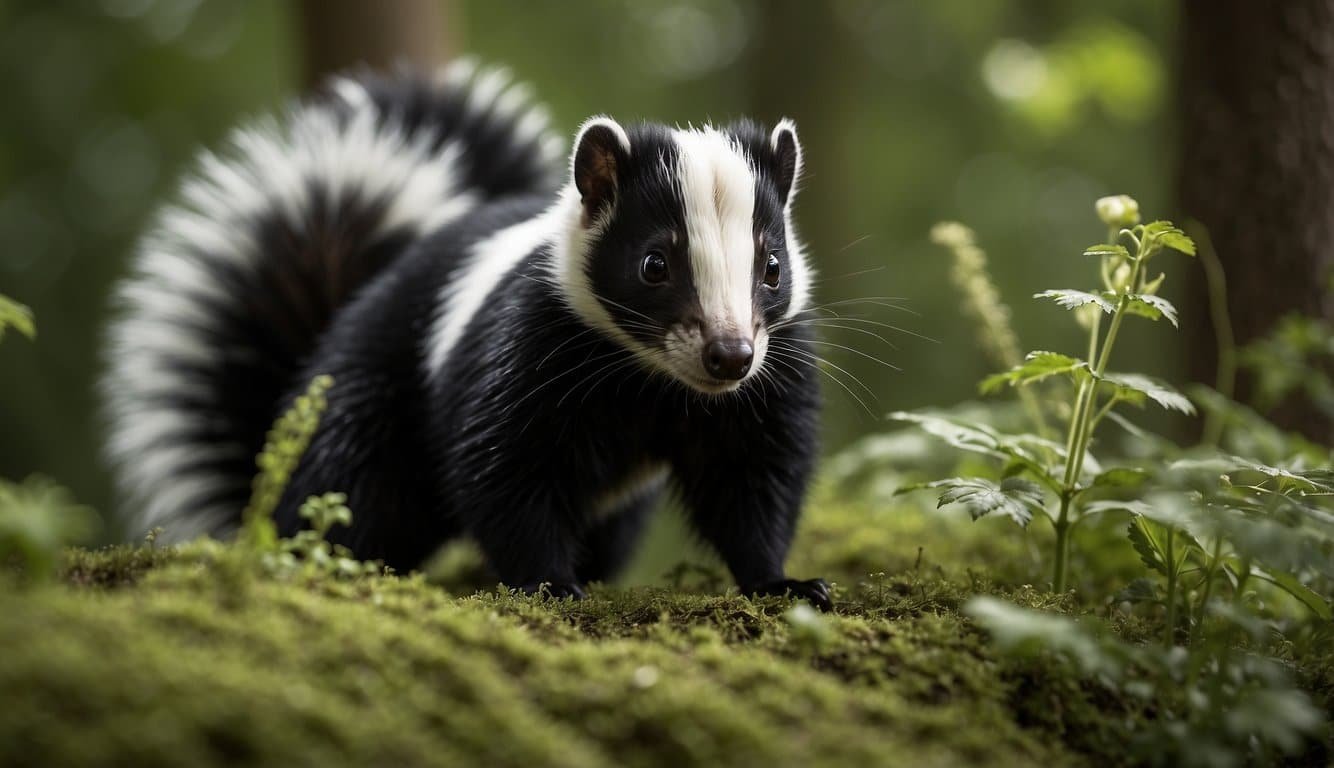Understanding Skunk Stripes
The iconic stripes of a skunk are not just for show—they play a crucial role in the animal’s survival strategies. From the striped skunk‘s distinctive fur pattern to its use in media, there’s more to these lines than meets the eye.
Biological Significance
Striped skunks, scientifically known as Mephitis mephitis, are renowned for their black fur with white stripes that run from their conical head along their back. This striping is a type of aposematic coloration, a vivid pattern that warns natural predators of the skunk’s potent defense mechanism—its musk-filled scent glands. The high contrast of these stripes against the body helps to make the warning clear even under low light conditions, and their sense of smell isn’t needed to understand this message.
Species and Habitat
This particular species of skunk is widespread, classified as “Least Concern” by the IUCN due to their large and stable population. Striped skunks have adapted to a variety of habitats across North America. They boast a hefty furred tail and sharp claws for digging up insects, which are a primary food source. The stripes of a striped skunk serve as a natural adaptation to their environment, providing a visual cue that can deter potential threats.
Usage in Popular Culture
The striped skunk has made numerous appearances in popular culture, often characterized by its striking fur pattern and memorable defense strategy. From comic strips to animated films, they are depicted as cunning yet lovable characters. Their endearing appearance and the dramatics involved in their signature scent-spraying antics have solidified their place in media as a symbol of both cuteness and caution.
Within these instances, the skunk’s stripe is usually at the center of attention, serving as an iconic visual element that is instantly recognizable to audiences. The portrayal of striped skunks in media has had an impact on public perception, shaping the narrative around these fascinating creatures and highlighting the unique features that make them stand out in the animal kingdom.
Environmental Interactions and Diet

Skunks hold peculiar positions in ecosystems, interacting with various elements, from the fauna they prey on to the predators they evade. Their diet is remarkably versatile, reflecting their adaptability and the influence of seasonal changes.
Skunks in Ecosystems
Skunks are integral to the ecosystems of North America, from Canada to Mexico. They serve as both predator and prey, maintaining the balance by controlling insect and small mammal populations. In particular, they are known to consume a wide range of arthropods, including beetles, crickets, and grasshoppers, which form a substantial part of their diet, especially during the summer months when these insects are most plentiful.
Predators and Threats
Despite their notorious defense mechanism, skunks have natural predators, including coyotes, bobcats, and great horned owls, which are seemingly unfazed by the skunk’s odoriferous spray. Humans also pose significant threats through habitat destruction and road casualties. In their interactions with these threats, skunks’ coloring serves as a natural warning system, which underlines the importance of their distinctive stripes.
Feeding Habits
The diet of skunks is omnivorous and changes with the availability of food sources throughout the seasons. Their nocturnal foraging might lead them to raid bees’ nests for honey, hunt for amphibians and reptiles, or scavenge for eggs and small mammals. Skunks are also known to feast on plant material, including nuts and corn, which makes them occasional visitors to human-inhabited areas where such food can be sourced more easily.
Skunk Stripes in Human Context

The iconic stripes of a skunk are not only key to their survival in the wild but also shape their presence and perception in human society.
Domestication Prospects
Skunks, known for their striking black-and-white striped coats and potent scent glands, present an interesting case when potential domestication is considered. While their Mephitis mephitis cousins have occasionally been kept as pets, the process requires scent gland removal to make cohabitation with humans more palatable. This procedure, coupled with their need for a specialized diet, makes skunks somewhat challenging companions, overshadowing the curiosity-driven interest they might elicit due to their unique patterns.
Cultural Depictions
The vibrant stripes of skunks have permeated cultural depictions, often coloring their portrayal in cartoons and children’s books as mischievous yet lovable characters. These depictions occasionally play on the tension between the beauty of their fur pattern and the infamous defensive stench their scent glands can produce. Moreover, indigenous narratives, such as those from the Cree culture, may incorporate skunks, recognizing both their distinctive appearance and their role in natural ecosystems where they interact with various predators like coyotes, bobcats, and great horned owls.
- Explore how skunk stripes affect wild carnivore behavior.
- Discover more about skunks’ cryptic nature.
- Learn about identifying individual striped skunks through their stripes.
- Investigate striped skunk scavenging patterns.
- Understand the spatiotemporal patterns of skunk rabies.

